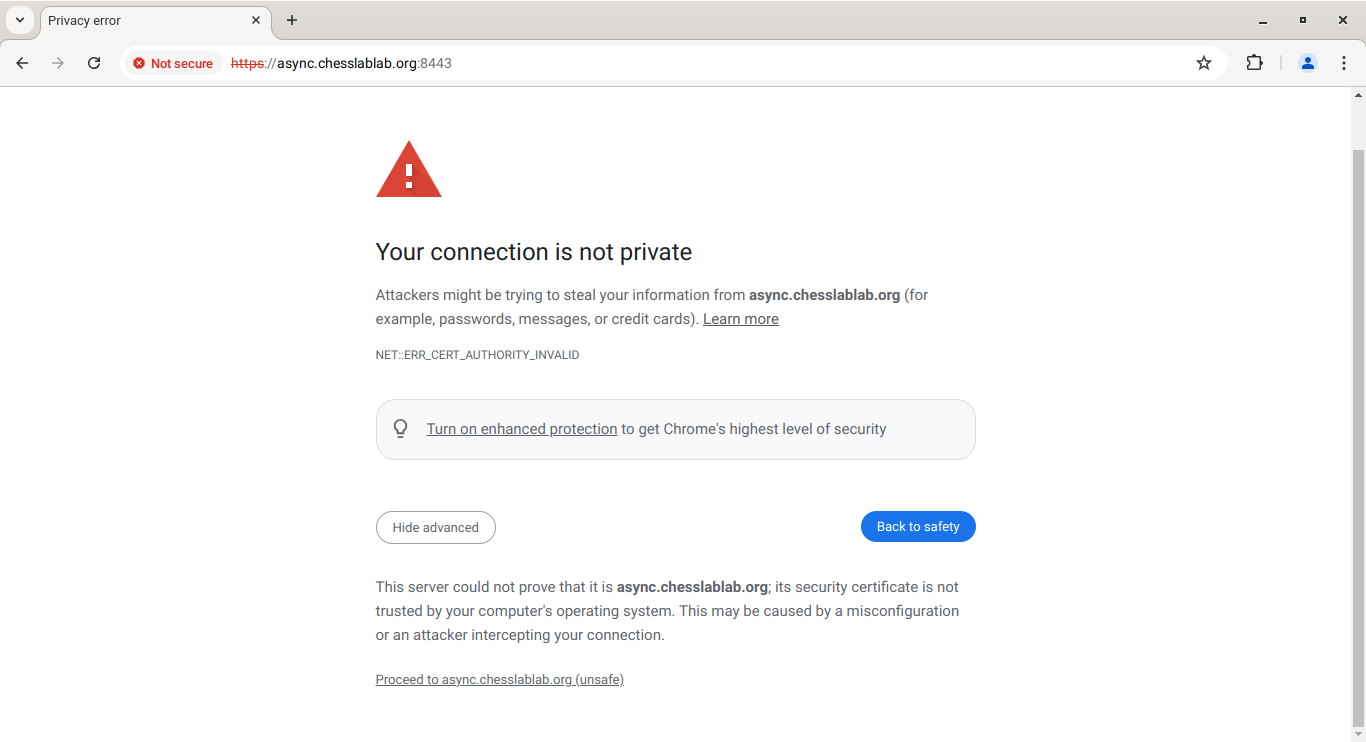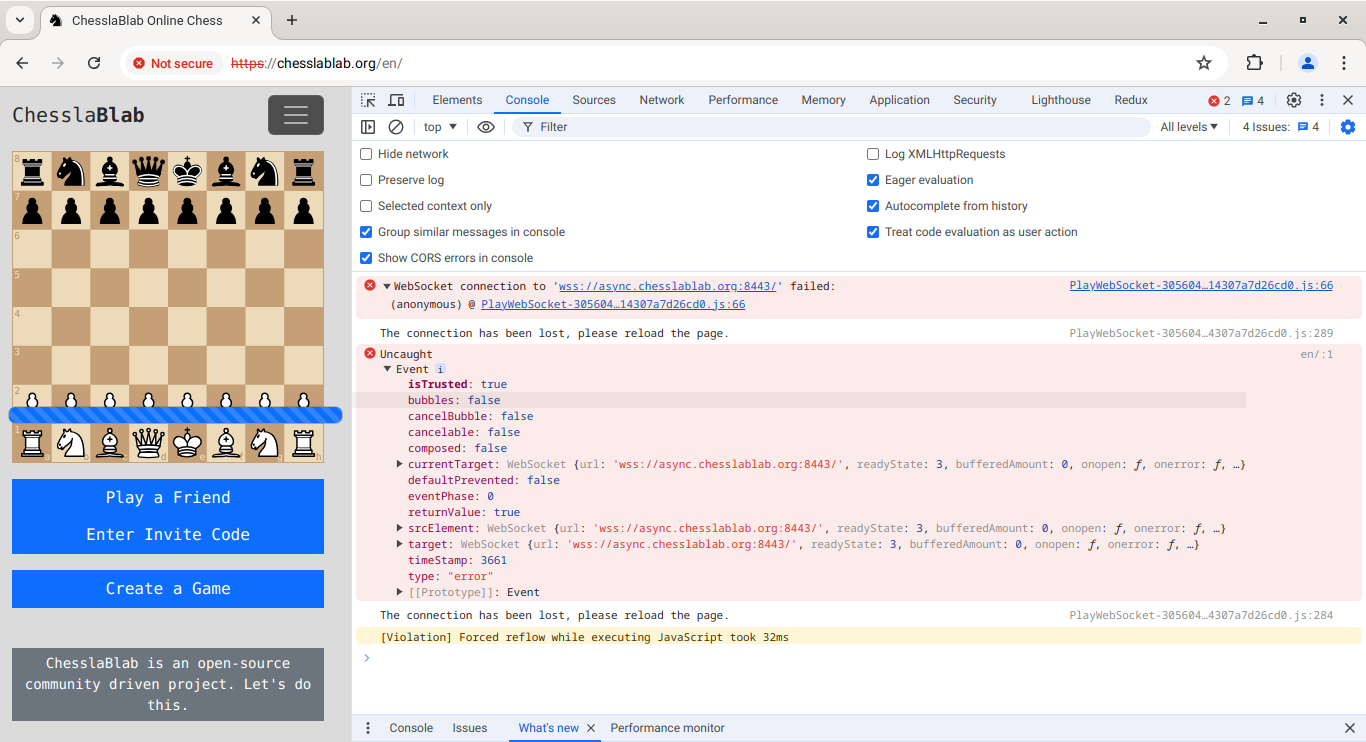Website
A free, open-source web app to learn and play chess online. Created with PHP and JavaScript, using Symfony and Bootstrap.
Available Environments
Development
The following repositories are required to run a complete chess platform in a local development environment:
Remember to add your PHP Chess Server host name to the assets/env.js file of your website.
Decentralized
With decentralized chess (DeChess) a complete chess platform can be run using one ChesslaBlab repository only:
Make sure to add at least a PHP Chess Server host name from the ChesslaBlab Node List to the assets/env.js file of your website.
SSL Certificate Setup
Some familiarity with Public Key Infrastructure (PKI) is recommended in order to follow this section.
Development Environment
The first thing you need to understand about setting up a ChesslaBlab website in a local development environment is that you have to create an SSL certificate to secure three different domain names at once.
chesslablab.orgwww.chesslablab.orgasync.chesslablab.org
This is because nowadays, major browsers want all traffic to be secure, and as a web developer you want the development environment to mimic production as much as possible.
The first two domain names, chesslablab.org and www.chesslablab.org, will point to the IP of the website. When it comes to websites, it is a common practice to create a domain alias that redirects to the primary domain. Hence the two domain names for the website, one starting with www. The async.chesslablab.org to the IP of the asynchronous chess server.
Decentralized Environment
In a decentralized environment only two domain names need to be secured.
chesslablab.orgwww.chesslablab.org
Use custom domain names to configure yours whether you are a chess club, a school, or a FIDE titled player.
yourchessclub.comwww.yourchessclub.com
Free SSL Certificate with Certbot
Probably the easiest way to proceed is to purchase a wildcard certificate from a Certificate Authority (CA) however you may want to consider to get your free certificate using Certbot instead. Be that as it may, keep in mind that before any CA can issue an SSL certificate, a validation process is required to verify that it can be sent to the Certificate Signing Request (CSR) requester.
This is typically achieved through one of the following methods.
-
Email Validation — a validation email is sent to the certificate requester.
-
HTTP Validation — the certificate requester is asked to upload a validation file at their host.
-
DNS Validation — the certificate requester sets up a CNAME record in the domain's DNS zone for further validation.
I used Certbot to automatically get a free HTTPS certificate. Since the ChesslaBlab website is running on an Ubuntu server, the certificate was validated through DNS as it is described next.
sudo certbot certonly --standalone
Saving debug log to /var/log/letsencrypt/letsencrypt.log
Please enter the domain name(s) you would like on your certificate (comma and/or
space separated) (Enter 'c' to cancel): chesslablab.org www.chesslablab.org async.chesslablab.org
Requesting a certificate for chesslablab.org and 2 more domains
Successfully received certificate.
Certificate is saved at: /etc/letsencrypt/live/chesslablab.org-0001/fullchain.pem
Key is saved at: /etc/letsencrypt/live/chesslablab.org-0001/privkey.pem
This certificate expires on 2024-04-23.
These files will be updated when the certificate renews.
Certbot has set up a scheduled task to automatically renew this certificate in the background.
- - - - - - - - - - - - - - - - - - - - - - - - - - - - - - - - - - - - - - - -
If you like Certbot, please consider supporting our work by:
* Donating to ISRG / Let's Encrypt: https://letsencrypt.org/donate
* Donating to EFF: https://eff.org/donate-le
- - - - - - - - - - - - - - - - - - - - - - - - - - - - - - - - - - - - - - - -
The certbot command generated two files, fullchain.pem and privkey.pem, that then were installed in each of the repos listed above:
- chesslablab/website
- chesslablab/chess-server
It is worth saying that for this to function properly, Certbot's documentation recommends to have a working web site that can already be accessed using HTTP on port 80.
Self-Signed SSL Certificate with OpenSSL
If issuing a certificate with DNS validation sounds too complicated to you, OpenSSL might be an alternate solution for the development environment. You may want to create a self-signed multi-domain SSL certificate using OpenSSL.
openssl genrsa -aes256 -passout pass:foobar -out chesslablab.org.pem 2048
openssl req -passin pass:foobar -new -sha256 -key chesslablab.org.pem -subj "/C=US/ST=CA/O=ChesslaBlab, Inc./CN=chesslablab.org" -reqexts SAN -config <(cat /etc/ssl/openssl.cnf <(printf "[SAN]\nsubjectAltName=DNS:*.mydomain.org")) -out chesslablab.org.csr
openssl x509 -passin pass:foobar -req -days 365 -in chesslablab.org.csr -signkey chesslablab.org.pem -out chesslablab.org.crt
openssl rsa -passin pass:foobar -in chesslablab.org.pem -out chesslablab.org.key
The command above will generate four files:
- chesslablab.org.crt
- chesslablab.org.csr
- chesslablab.org.key
- chesslablab.org.pem
Then, chesslablab.org.crt and chesslablab.org.key must be renamed in order to match both the certificate and the key filename created by Certbot. As noted before, it is assumed that Certbot is used to automatically generate the HTTPS certificate so all repositories are configured to read these two files on startup.
mv chesslablab.org.crt fullchain.pem
mv chesslablab.org.key privkey.pem
At this point, it is of vital importance to add the chess server's self-signed certificate as trusted to your browser.

Figure 1. Make the browser trust the chess server's self-signed certificate.
If skipping this step, the web browser won't be able to connect to the chess server. The latter will complain with an SSL handshake error.
SSL handshake error: stream_socket_enable_crypto(): SSL operation failed with code 1. OpenSSL Error messages:
error:14094416:SSL routines:ssl3_read_bytes:sslv3 alert certificate unknown
And the web browser will throw an error accordingly.
WebSocket connection to 'wss://async.chesslablab.org:8443/' failed

Figure 2. WebSocket connection to 'wss://async.chesslablab.org:8443/' failed.
Let's recap!
In order to set up a local development environment, three different domain names need to be secured at once. The SSL certificate is to be installed in each of the following repositories.
- chesslablab/website
- chesslablab/chess-server
In a decentralized environment only two domain names need to be secured. The SSL certificate is to be installed in the following repository.
- chesslablab/website
Certbot can be used to automatically get a free HTTPS certificate, however, if this still sounds too complicated, OpenSSL might be an alternate solution for the development environment.
Customization
The default settings can be customized through the environment variables in the .env file. Change the site name and the locale to configure your website whether you are a chess club, a school, or a FIDE titled player.
SET_SITE_NAME=YourChessClub
SET_LOCALE=es
The supported locales are described in the following table.
| Locale | Description |
|---|---|
| de | German |
| en | English |
| es | Spanish |
| fr | French |
| ru | Russian |
| tr | Turkish |
| hi | Hindi |
| zh_CN | Chinese (Simplified) |
Installation
Clone the chesslablab/website repo into your projects folder. Then cd the website directory and create an .env file:
cp .env.example .env
Update the .env file to your specific needs.
Set up the browser environment variables:
cp assets/env.example.js assets/env.js
Update the env.js file to your specific needs.
Make sure to have installed the fullchain.pem and privkey.pem files into the docker/nginx/ssl folder, and run the Docker containers in detached mode in the background:
docker compose -f docker-compose.default.yml up -d
Clear the cache:
docker exec -itu 1000:1000 chess_website_php php bin/console cache:clear
Download the assets:
docker exec -itu 1000:1000 chess_website_php php bin/console importmap:install
Compile the assets:
docker exec -itu 1000:1000 chess_website_php php bin/console asset-map:compile
Finally, if you are running the website in a local development environment, you may want to add a domain name entry to your /etc/hosts file.
127.0.0.1 chesslablab.org